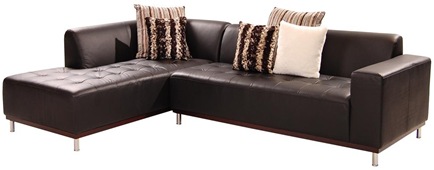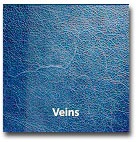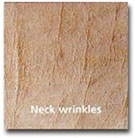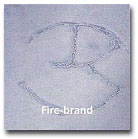Now that you know all about the history of leather, you’ve got a hankerin’ to go and get some leather for yourself. Great! Before you head out, though, you may want to take a moment to familiarize yourself with the different types of leather.
A common misconception is that all leather is the same. The fact is that the quality of leather varies based on two important factors:
- The animal from which it came
- The tanning process used
These factors not only determine the quality of the leather, but its feel and durability as well. That means that certain types of leather are better suited than others for use in particular products. We’re not going to cover every type leather here, but we’ll go over the most common ones to give you an idea of what you’ll be looking at.
Full/Top Grain Leather – Easily the highest quality leather on the market. In the leather world, the term “grain” refers to the pattern visible on the outer surface of the skin once the hair has been removed. This pattern typically consists of pores and any other unique markings or injuries the animal’s skin may have, including mosquito bites, scratches, branding, wrinkles, and more. Full/Top grain leather is one of the purest forms of leather in that the outer surface of the skin has not been buffed or treated for uniformity. In other words, what you see is what you get; all those pores and bites and scratches the animal has on its skin? They’re not going anywhere.
Ironically, many people buy a beautiful piece of full/top grain leather furniture only to find one of these natural markings on it. They immediately perceive the marking as a defect and demand an exchange or a refund. However, these markings are part of what make full/top grain leather so unique and valuable. Has someone ever put a dent in your car and tried to play it down by telling you the dent “adds character?” They’re usually just looking for a way out of having to pay for repairs, but in the case of leather, these markings really do add character.
Full/Top grain leather tends to be more durable than other leather types since the top grain has not been altered. It’s also more breathable, so your skin won’t stick to it after prolonged contact. You’ll usually find full/top grain leather in furniture like couches, sofas, and recliners.
Corrected Grain Leather – This is exactly what it sounds like. Whereas full/top grain leather has opted to go au naturale, resisting any cosmetic procedures, corrected grain, embarrassed by her spots and blemishes, wants to have them removed. As such, corrected grain leather is leather whose grain has been buffed or treated to remove imperfections. Buffing alone isn’t enough, however; the procedure changes the fundamental pattern of the 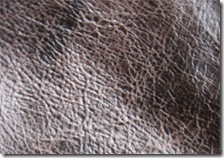 grain itself, leaving a very noticeable smooth spot that differs from the rest of the grain. This is “corrected” by applying a finish (or paint) that closely matches the original grain pattern. The result? A completely spotless and uniform piece of leather that looks great! (But we all know she’s had some work done.)
grain itself, leaving a very noticeable smooth spot that differs from the rest of the grain. This is “corrected” by applying a finish (or paint) that closely matches the original grain pattern. The result? A completely spotless and uniform piece of leather that looks great! (But we all know she’s had some work done.)
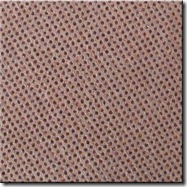 Split Leather – When the top grain of a hide has been removed, you are left with the layer beneath; split leather is made using this layer. Split leather tends to be more fragile than full/top grain leather and can be easily damaged if not properly cared for. It has a soft, fuzzy feel and is not naturally waterproof like full/top grain leather. Split leather is cheaper than full/top grain leather and is commonly used to make suede.
Split Leather – When the top grain of a hide has been removed, you are left with the layer beneath; split leather is made using this layer. Split leather tends to be more fragile than full/top grain leather and can be easily damaged if not properly cared for. It has a soft, fuzzy feel and is not naturally waterproof like full/top grain leather. Split leather is cheaper than full/top grain leather and is commonly used to make suede.
Coated/Bycast Leather– This leather is made by applying a layer of polyurethane to the surface of split leather. This results in increased durability. Coated/Bycast leather was once used exclusively in shoes, but its low price led to its use in upholstery as well. Many public places with seating (such as bars and restaurants) use coated/bycast leather on their furniture.
Bonded Leather – Bonded leather is a mostly synthetic material made up of 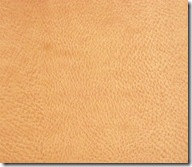 varying degrees of genuine leather combined with other materials (usually polyurethane or vinyl) to give the appearance of leather. This is the least expensive type of leather (aside from synthetic leather) on the market. Bonded leather is typically found on Bibles, diaries, art books, and desk accessories.
varying degrees of genuine leather combined with other materials (usually polyurethane or vinyl) to give the appearance of leather. This is the least expensive type of leather (aside from synthetic leather) on the market. Bonded leather is typically found on Bibles, diaries, art books, and desk accessories.
Once the grain has been “cut,” it’s time to apply a finish. The finish is essentially a protective coating that enhances the leather’s durability and longevity, but can also give the leather a specific texture or color if so desired. Again, there are many more finishes than those listed here, but these are the most common.
Aniline Finish – Aniline leather is leather that has been treated with a completely transparent finish. In other words, the original grain is completely visible with the naked eye.
Semi-Aniline Finish – This leather has been treated with a semi-transparent finish, giving off a slight hint of color, but still not obstructing the original grain.
Pigmented Finish – Pigmented leather has been treated with a completely opaque finish. Essentially, this is like painting or coloring the leather. The original grain in this leather is not visible.
When shopping for leather, most products will clearly state the type of leather used. If you can’t find this information, just ask a sales associate. The important thing is that you are well informed about the type of leather you’re investing in. Get a head start on your leather quest by checking out our huge selection of leather furniture at www.ElDoradoFurniture.com!
Narratives are for entertainment purposes only and frequently employ literary point of view; the narratives do not necessarily reflect the opinions of El Dorado Furniture, its officers, or employees.
Have a comment or topic suggestion for the author? Shoot him an e-mail at vcapo@eldoradofurniture.com.
Sources:
“Natural Characteristics of Leather” Leather Resource Website, http://www.leatherresource.com/naturalcharacteristics.html (accessed June 29, 2010).
“Terms” Leather Resource Website, http://www.leatherresource.com/terms.html (accessed July 5, 2010).
“What are the different types of leather?” Wisegeek Website, http://www.wisegeek.com/what-are-the-different-types-of-leather.htm (access July 5, 2010).
“Different Types of Leather” Buzzle Website, http://www.buzzle.com/articles/different-types-of-leather.html (accessed July 5, 2010).
“Leather” Wikipedia Website, http://en.wikipedia.org/wiki/Leather (accessed July 5, 2010).
“The Various Types of Leather Used in Leather Furniture” Home Furniture From North Carolina Website, http://northcarolinahomefurnitureblog.com/?p=116 (accessed July 5, 2010).
“Definitions” Leather Resource Laboratory, http://www.leatherusa.org/i4a/pages/index.cfm?pageid=3285 (accessed July 5, 2010).

